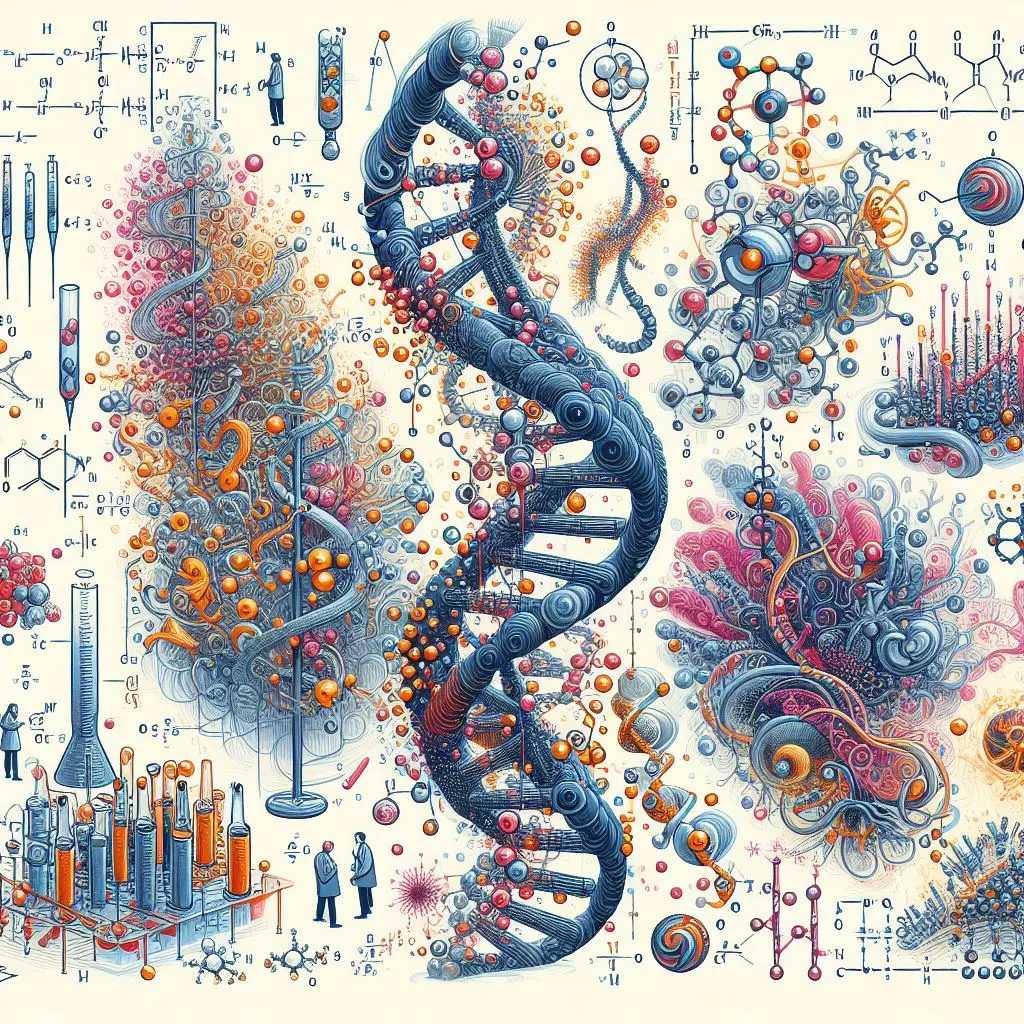Calculus in Biology and Medicine: Modeling Dynamic Biological Systems

Calculus, a branch of mathematics meticulously crafted by luminaries Sir Isaac Newton and Gottfried Wilhelm Leibniz in the late 17th century, has seamlessly woven itself into the fabric of various scientific disciplines, emerging as an indispensable tool in the realm of biology and medicine. Within this dynamic intersection, calculus assumes a pivotal role, offering a lens through which the intricacies of living organisms are scrutinized and understood. In the following discourse, we embark on a journey to explore the multifaceted applications of calculus in modeling the ever-evolving biological systems that govern life itself. Whether dissecting the ebbs and flows of population dynamics or scrutinizing the nuances of physiological processes, calculus stands as an omnipresent guide, furnishing biologists and medical researchers with robust tools to navigate the complex tapestry of life. If you need assistance with your calculus assignment, it's essential to recognize calculus as the foundational framework that underpins various biological and medical analyses. From modeling growth patterns with differentiation to understanding drug absorption and elimination through integration, calculus provides a powerful toolkit for tackling real-world problems in biology and medicine.

From the transmission of neural signals, a domain where the firing patterns of neurons and synaptic transmissions become quantifiable through mathematical descriptions, to the intricate dance of gene expression dynamics, differential equations unravel the regulatory intricacies that underpin developmental processes and disease mechanisms. Epidemiology, the mathematical battleground of disease spread, employs differential equations to forecast the trajectories of infectious outbreaks, informing public health interventions and vaccination strategies. In the realm of oncology, differential equations lend their prowess to modeling cancer growth, providing oncologists with predictive tools to tailor personalized treatment plans. As we delve deeper into the applications of calculus in medicine, its role in advanced imaging techniques such as MRI, CT scans, and PET scans becomes evident. Through the mathematical underpinnings of these technologies, calculus empowers healthcare professionals to interpret diagnostic images with precision, contributing to accurate diagnoses and informed medical decisions. In the broader canvas of systems biology, calculus forms the backbone of mathematical models that simulate the behavior of interconnected biological components, ushering in a new era of comprehensive understanding in biological research. In conclusion, calculus emerges not merely as a mathematical discipline but as a guiding force shaping the trajectory of biological and medical advancements. Its application transcends equations and symbols, manifesting as a powerful ally in the relentless pursuit of unraveling the mysteries of life.
Foundations of Calculus
The foundations of calculus lie in its two fundamental concepts: differentiation and integration. Through differentiation, we gain the ability to analyze the rate at which a quantity changes, a crucial tool in understanding dynamic biological processes. In the context of population dynamics, derivatives facilitate the modeling and examination of growth patterns, offering insights into how populations expand and eventually stabilize within their ecological niches. This mathematical approach proves invaluable in ecological studies, aiding biologists in predicting and managing the behavior of various species. Similarly, within the realm of medicine, differentiation plays a pivotal role in understanding enzyme kinetics, enabling the modeling of the rates of biochemical reactions. Enzyme-substrate interactions, essential in drug development and therapeutic interventions, are scrutinized using calculus to optimize drug concentrations and enhance treatment efficacy. Moving to the reverse process, integration, this mathematical operation allows us to find the accumulation of quantities over time. In the field of drug administration, integration assists in modeling drug absorption, distribution, metabolism, and elimination, contributing to the development of effective dosage regimens. Furthermore, when applied to the circulatory system, integration helps calculate critical parameters such as cardiac output and blood pressure, providing medical professionals with valuable insights into blood flow dynamics. Thus, the foundational principles of calculus empower researchers and medical practitioners alike, offering a robust mathematical framework for comprehending and manipulating dynamic biological systems.
A. Differentiation
Calculus begins with the concept of differentiation, which allows us to analyze the rate at which a quantity changes. In biology, this is particularly useful when studying growth patterns of populations or analyzing the rates of biochemical reactions within cells. We'll delve into how derivatives help us understand these dynamic processes.
1. Population Dynamics
Population growth is a fundamental concept in biology, and calculus enables us to model and analyze it effectively. The logistic growth equation, derived using differential equations, provides insights into how populations expand and eventually stabilize in realistic ecological settings.
2. Enzyme Kinetics
Within the realm of medicine, understanding enzyme kinetics is crucial for drug development and therapeutic interventions. Calculus helps model the rate of enzyme-substrate interactions, guiding researchers in optimizing drug concentrations and treatment efficacy.
B. Integration
Integration, the reverse process of differentiation, allows us to find the accumulation of quantities over time. In biology and medicine, integration proves essential for understanding the total impact of dynamic processes.
1. Drug Absorption and Elimination
When administering drugs, it's vital to comprehend how they are absorbed, distributed, metabolized, and eliminated. Integration helps model drug concentration over time, aiding in the design of effective dosage regimens.
2. Modeling Blood Flow
The circulatory system is a complex network of vessels and organs, and calculus assists in modeling blood flow dynamics. Integration helps calculate cardiac output, blood pressure, and other critical parameters, offering valuable insights for medical professionals.
Differential Equations in Biology
Differential equations, a cornerstone of mathematical modeling, play a pivotal role in elucidating dynamic biological processes within the realm of biology. At the cellular level, these equations are instrumental in deciphering complex phenomena such as neural signal transmission. In the intricate neural networks of the brain, differential equations are deployed to model the intricate patterns of signal propagation between neurons, shedding light on the mechanisms behind synaptic transmission and neuronal firing. Moreover, these equations find application in elucidating the dynamics of gene expression, a fundamental process governing the regulation of genetic information. By employing differential equations, researchers can unravel the intricacies of how genes respond to environmental stimuli, providing crucial insights into developmental processes and disease mechanisms. In the field of epidemiology, differential equations serve as invaluable tools for modeling the spread of infectious diseases. Compartmental models, rooted in these equations, allow scientists to predict and understand the progression of epidemics, informing the implementation of effective public health interventions and vaccination strategies. Furthermore, differential equations find profound applications in oncology, enabling the modeling of cancerous tumor growth and response to various treatment modalities. This approach empowers oncologists to devise personalized and targeted therapeutic strategies for cancer patients. As such, the integration of differential equations into biological research exemplifies their indispensable role in unraveling the dynamic intricacies of living systems, paving the way for advancements in medicine and a deeper understanding of the complex processes governing life.
A. Cellular Processes
1. Neural Signal Transmission
In neuroscience, differential equations are employed to model the transmission of signals between neurons. This enables researchers to understand complex processes like synaptic transmission and neuronal firing patterns.
2. Gene Expression Dynamics
Differential equations are used to describe the dynamic regulation of gene expression. This is crucial for understanding how genes are activated or suppressed in response to environmental cues, offering insights into developmental processes and disease mechanisms.
B. Epidemiology
1. Disease Spread Modeling
The spread of infectious diseases can be modeled using compartmental models based on differential equations. Calculus helps predict the progression of epidemics, guiding public health interventions and vaccination strategies.
2. Cancer Growth and Treatment
Differential equations are applied to model the growth of cancerous tumors and the impact of different treatment modalities. This aids oncologists in devising personalized treatment plans for cancer patients.
Advanced Applications in Medicine
Advanced applications of calculus in medicine have revolutionized diagnostic and therapeutic approaches, shaping the forefront of healthcare. In the realm of medical imaging, techniques such as Magnetic Resonance Imaging (MRI), Computed Tomography (CT) scans, and Positron Emission Tomography (PET) scans rely heavily on calculus principles. Understanding the mathematical foundations of these imaging modalities is imperative for healthcare professionals to interpret intricate images, aiding in accurate diagnoses and treatment planning. Furthermore, calculus plays a pivotal role in Systems Biology, a multidisciplinary field integrating mathematical modeling, experimental data, and computational analysis to comprehend the complexity of biological systems. By employing calculus, researchers can develop mathematical models that simulate the behavior of interconnected biological components, facilitating a holistic understanding of cellular processes and interactions. This systems-level perspective is instrumental in deciphering the molecular underpinnings of diseases and devising targeted therapeutic interventions. As technology advances and interdisciplinary collaboration thrives, calculus remains an indispensable tool, driving innovations that enhance medical imaging precision, refine treatment strategies, and ultimately contribute to the evolution of medical science. The integration of calculus into advanced medical applications underscores its enduring significance in pushing the boundaries of knowledge and improving healthcare outcomes for patients worldwide.
A. Imaging Techniques
Calculus is instrumental in medical imaging techniques like MRI, CT scans, and PET scans. By understanding the mathematical principles behind these technologies, healthcare professionals can interpret images accurately and diagnose conditions effectively.
B. Systems Biology
Systems biology integrates mathematical modeling, experimental data, and computational analysis to understand complex biological systems comprehensively. Calculus is a foundational tool in developing mathematical models that simulate the behavior of interconnected biological components.
Conclusion
In conclusion, the symbiotic relationship between calculus and the realms of biology and medicine is undeniably profound. As we've explored the fundamental concepts of differentiation and integration, it becomes evident how these mathematical tools form the backbone of modeling dynamic biological systems. From deciphering population growth patterns to optimizing drug dosages, calculus provides invaluable insights. The application of differential equations in understanding cellular processes, such as neural signal transmission and gene expression dynamics, underscores the role of calculus in elucidating the intricacies of life at the microscopic level. In epidemiology, calculus aids in predicting the spread of diseases, offering a strategic advantage in public health planning. Moreover, its advanced applications in medical imaging and systems biology showcase the versatility of calculus in shaping the future of healthcare. As we stand at the intersection of mathematics and life sciences, it is clear that calculus is not merely a theoretical construct but a pragmatic tool driving innovations, guiding medical interventions, and unlocking the secrets of biological complexity. The journey from the foundational principles laid down by Newton and Leibniz to the forefront of contemporary medical research highlights the enduring significance of calculus in the pursuit of understanding, treating, and enhancing life. The trajectory of calculus in biology and medicine is an evolving narrative, promising continued revelations and breakthroughs that will reshape the landscape of healthcare and deepen our comprehension of the intricate dance of life.